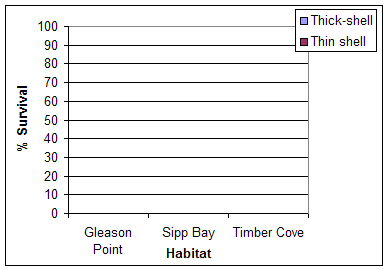 |
Plants & Human Affairs (BIOL106) - Stephen G. Saupe, Ph.D.; Biology Department, College of St. Benedict/St. John's University, Collegeville, MN 56321; ssaupe@csbsju.edu; http://www.employees.csbsju.edu/ssaupe |
 |
Plants & Human Affairs (BIOL106) - Stephen G. Saupe, Ph.D.; Biology Department, College of St. Benedict/St. John's University, Collegeville, MN 56321; ssaupe@csbsju.edu; http://www.employees.csbsju.edu/ssaupe |
A Crabby Assignment
The periwinkle is a small (ca. 1 cm long) marine snail that lives in the intertidal zone in New England. Among this snail's predators is the European green crab. Before 1900, the green crab did not occur north of Cape Cod, MA. After the turn of the century, however, the crab expanded its range northward, and is now found as far north as Nova Scotia. The crab's range expansion exposed the periwinkle populations north of Cape Cod to a new agent of natural selection.
Suggest at least three hypotheses to explain how populations of
periwinkles might evolve in response to predation by green crabs.
Biologist Robin Seeley investigated whether populations evolved in response to predation by green crabs. Seeley found, in a museum, samples of pre-1900 shells collected at Appledore Island, north of Cape Cod. She compared these old shells to those collected more recently at the same place. Seeley's data appear in the table below.
| Table 1. Diameter of periwinkle shells collected north of Cape Cod. (units are arbitrary) | |||||||||||||||||||||||||||||||||||||||||||||||||||||||||||||||||||||||||||||||||
| Shells collected in 1871 | Shells collected in 1982-1983 | ||||||||||||||||||||||||||||||||||||||||||||||||||||||||||||||||||||||||||||||||
|
|
||||||||||||||||||||||||||||||||||||||||||||||||||||||||||||||||||||||||||||||||
On the graph below, plot a frequency distribution of Seeley's data to allow you to visually compare the variation in shell thickness in the two populations. Label the Y axis - number of individuals and label the X axis - shell thickness. Then plot your data on the graphs.
| 1871 population | ||||||||||||||||||||||
| 1882-3 population | ||||||||||||||||||||||
What is the pattern in Seeley's data? Does this
pattern suggest that the snail population of Appledore Island evolved in
response to the arrival of the crabs? Explain.
Develop a specific hypothesis for the nature of the
interaction between the snails and crabs that might have caused the snail
population to evolve.
Design an experiment that would test to see if your
hypothesis is correct. Describe the results you'll get if your
hypothesis is correct, and the results you'll get if your hypothesis is
incorrect.
Seeley herself performed two experiments. In the lab, she offered each of 8 crabs a thin-shelled snail. All 8 crabs quickly crushed and ate their snails. It took them an average of 42 seconds. Seeley offered each of another 8 crabs a thick-shelled snail. Only one of these was able to crush and eat its snail within 8 minutes. During that time many of the other crabs gave up trying.
In the field, Seeley drilled small holes in the shells of a number of snails and used fishing line to tether the snails to seaweeds in the intertidal zone. She returned every few days to see which snails survived. This method allowed Seeley to distinguish between snails that were killed by crabs (part of their shell remain tied to their tethers, and those that broke free of their tethers or died in their shells. She tethered the snails in pairs, with each pair including one thin-shelled snail and one thick shelled snail. She tethered 15 pairs at Timber Cove where crabs appear absent, 15 pairs at Sipp Bay where crabs are present but rare; and 15 pairs at Gleason Point where crabs are common. She checked on the snail after 6, 9 and 16 days. Her data are presented in Table 2.
| Table 2: Survival of thin & thick-shelled snails after 15 days tethered in habitats with no (Timber Cove), few (Sipp Bay) and many (Gleason Point) green crabs | |||
| Gleason Point | Sipp Bay | Timber Cove | |
| % thick-shell surviving | 65 | 80 | 100 |
| % thin-shell surviving | 25 | 40 | 100 |

References:
I obtained this exercise at a conference entitled, "Bio-Forum: Teaching in the
New Millenium," that I attended at the University of Minnesota, St. Paul in
April 2001. Sadly I can't remember the of the presenter who shared this
exercise that I have adopted largely in its entirety.
Last updated: 10/10/2005 � Copyright by SG Saupe